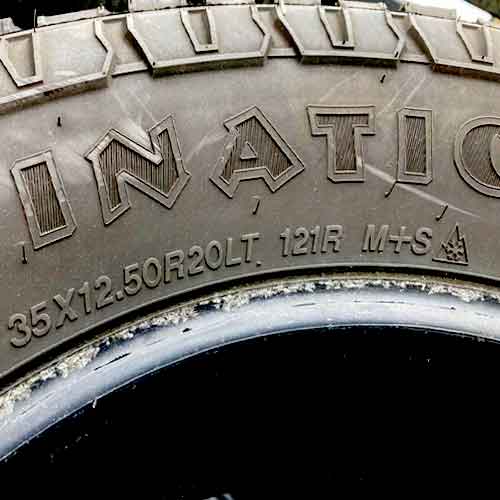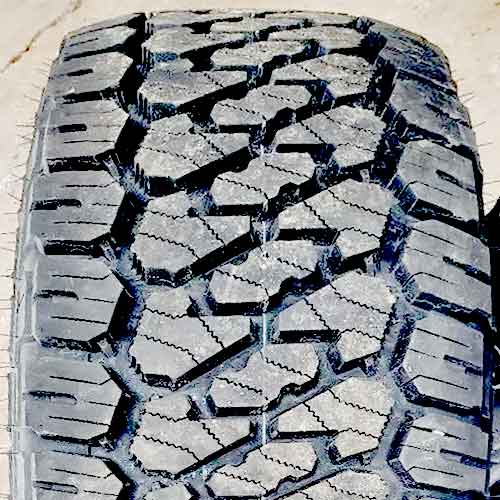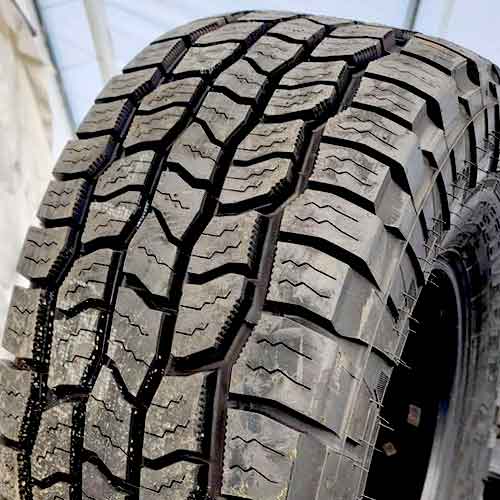Both the Firestone Destination X/T and the Cooper Discoverer AT3 are on-road oriented all terrain tires, providing all season traction (earning 3PMSR and M+S ratings). And off road, these tires don’t back down from any challenge, thanks to their powerful sides and deep biters. Could these be the new go-to choice for mild off-roading?

Being a tire engineer from my perspective the Firestone Destination X/T offers superior snow grip, absorption to bumps and fuel economy. And off-road, this tire brings in better rock climbing efficacy, and mud evacuation. Cooper Discoverer AT3 in comparison, offers better dry and wet performance on pavements, and does great on sandy dunes, off-road. Moreover, it on-road-ride is very silent, though its slightly bumpier.
Table of Contents
Sizes
Firestone Destination X/T supplies sizes in 15 to 20 inches (wheel diameter). And they have following specs.
- Speed ratings: R and S.
- Load ratings: C and E.
- Weight Range: 35 to 60 lbs.
- Tread Depth Range: 14, 15, 16 and 17/32″.
- All sizes have 50k miles warranty.
Moving towards the Cooper Discoverer AT3 XLT, this tire comes with 15″ to 20″ rim sizes, and they have following specs.
- Speed ratings of either R or S.
- Load range: C to F.
- Weight range: 44 lbs to 70 lbs.
- Tread depth: 16.5 or 17/32″.
- Warranty: 60k miles.
Outer Construction
The Firestone Destination X/T consists of 2 main ribs in the middle, they tried to make them look like “F” and “S” shaped (Firestone’s initials), but the F looks more of a U. Though whatever, shapes they are they offer a pretty good bite.

The “S” shaped slanted blocks are slightly smaller, and they are equipped with full depth wave-like siping.
While the other wrapped ones are not only bigger, they also have some additional features as well.
They have sharp biters on their outer edges (technical term for that is snow vice), and to restrict their movement a lot (as the tread compound is softer), they are supported by ridges on sides.
All of these lugs in central ribs, make an interconnected web of grooves, though they are narrower compared to outer circumferential channels channels, still.
These outer channels separate the shoulder lugs aside, which have slightly different siping pattern, (rectilinear), and towards their outer edges, they have prominent slits in them.
Moreover, these lugs are staggered and form “U” shaped sidewall lugs for off road bite.
The Cooper Discoverer AT3 “XLT” on the other hand, is a tire that truly stands out, thanks to its aggressive sidewalls, which feature lugs that are thicker and more robust than those found on other variants (4S, and LT).

When you lower the tire’s (air) pressure, these lugs provide extra tread for tackling rougher terrains, and they’re also connected to the shoulder blocks, though they are missing stone ejectors due to smaller gaps.
That’s because these gaps feature connectors known as Whisper Grooves.
Moreover, the inner edges of the shoulder blocks have sharp teeth, called snow vices, which help to improve the tire’s winter performance.
In the middle of the tire, you’ll find four vertical channels, with the outer ones being broader and equipped with those “snow vices”.
Each rib has block pairs, that are connected to each other with rubber underneath, providing reinforced support and enhanced traction and grip.
The blocks are also fitted with 3D full depth sipes that feature interlock technology. Though they don’t divide the lugs open (off-road), like the Firestone X/T.
Internal Construction
All-terrain tires are made tough, through their internal construction and the composition of the rubber on the tread.
So although both tires have a powerful cut resistant rubber on top, and 2 ply polyester/2 steel belts, the Cooper AT3 only offers a single cap ply of nylon on top, whereas the Firestone X/T gives you 2.
So, you can say this tire is slightly more durable overall, though both feature similar 2 ply sidewalls, so its not going to make too much of a difference.
Wet Traction
The overall wet performance of a tire is a combination of grip, and hydroplaning resistance, and both are equally significant for effective water removal beneath the tire, which is how traction is achieved.
Now although the Firestone Destination X/T yields better hydroplaning resistance due to it’s more open design, (allowing better water removal, especially from sideways), it’s wet traction overall is still not impressive, due to it’s less-effective siping on the shoulder lugs.
Most of the wet cornering grip actually comes from the outer ribs of the tread, and Firestone Destination X/T has very blocky shoulder lugs, with rectilinear siping, which get stiff during turning.
That’s why the siping on this tire isn’t able flex enough to clear ample water out, comparatively.
The Cooper AT3 on the other side, has interlocking sipes all over the tread, so it’s provides much better results.
Dry Performance
Evaluating the dry performance of these all-terrain tires, I calculated 3 key factors: traction, steering, and cornering ability. Let’s me explain each of these below.
Steering Feedback
The continuity of the center and sideways section is crucial for rapid steering response, but this gets more and more difficult with tire’s increasing aggressiveness.
That’s why it makes sense why out of the two, the Firestone Destination X/T lacks more, despite both of them having similar weight (as larger weight accounts for under-steering, increasing lag times).
With smoother composition (comparatively), the Cooper AT3 basically forms a more stronger and connected bond with the road, as it rolls.
Here all it’s lugs which are joined together with each other also ensures the stability remains in tact at all times. That’s why you get a more responsive tire in it’s case.
Dry Grip
While all-terrain tires are expected to meet a certain standard of traction, this is typically the easiest factor for them to satisfy.
Firestone Destination X/T is although not bad when it comes to gripping on dry, but compared to Cooper, it lacks, with quite some margin, I should add. (It basically shows up with 8 feet higher braking distances).
That’s because the middle area of the tread makes the most contact with the surface, and it’s smaller S shaped lugs there don’t make enough connection to create as much frictional forces.
Cooper Discoverer AT3 XLT on the other side, make a more streamlined on-road oriented design with it’s 5 rib design.
The tire also makes wider lugs in the middle, and since all lugs run in pairs, the overall dry grip stays enhanced.
Dry Handling
Handling is similar to grip, but refers specifically to the tire’s performance when turning. When a tire corners, the weight is shifted towards shoulders, and they are the ones responsible for maintaining contact with the road.
That’s why with less lateral grooves between shoulder lugs, the Cooper AT3 yields better lateral traction g forces, in comparison.
The Firestone Destination X/T although has a very on road-oriented shoulder blocks, with minimal tread features, promoting rubber to road connection, the lateral gaps limits that, and don’t allow these lugs to have as much stability.
Fuel Consumption
Both of these depend upon rolling resistance values a tire generates, which basically tell how much friction is being produced.
The Cooper Discoverer AT3 is although on-road oriented, and features a more streamlined design, it’s heavier weight causes it’s softer rubber to rub off with more friction (with the road).
Firestone Destination X/T on the other side, features a lighter construction so its lugs still get to bear less pressure on them overall, which allows it to stay more fuel efficient.
Tread Wear
How many miles a tire would last although also depends on rolling resistance values, the tread depth and rubber make-up are also considered.
That’s why Cooper AT3, despite having greater rolling resistance, provides better mileage, with it’s larger average tread depth which take longer to burn.
The Firestone Destination X/T on the other hand, although also offers similar (max) tread depth of 17/32″, its softer rubber is still more susceptible to faster wear, that’s why it gives 10k less mileage warranty as well.
Snow Performance
The key elements of winter traction include the tire’s ability to maintain forward momentum, cornering capability, and braking response on a variety of snowy surfaces.
And in all these factors, the tire is greatly helped by its snow grabbing abilities, (because snow sticks better on snow).
That’s why with a lot more biting edges (snow vices), the Firestone Destination X/T stays one step ahead, despite both tires having 3 peak mountain snowflake ratings.
It’s interconnected grooves laced with zigzag teeth of snow vices carry more potential of grabbing the snow, and trapping it in it’s grooves.
Cooper Discoverer AT3 XLT on the other hand, although also offers snow vices (on outer longitudinal channels), they still are not as effective in producing bite, comparatively.
Off-Road Performance
Some off-road terrains, like mud, can be particularly challenging while others, like gravel and dirt roads, can be handled through with ease. I’ve mentioned all these terrain types below.
Rocky Trails
When driving on rocky terrain, it can be helpful to lower the tire pressure for increased traction. This allows the middle lugs to have better chewing efficiency, and sidewall lugs to provide enhanced footprint.
But if the tread is already malleable, lowering pressure produces greater results.
That’s why with more overall number of biters, and a softer composition, the Firestone X/T offers superior gripping abilities.
The Cooper AT3 on the other side, lacks a lot in providing any kind of notches, if you consider its tread again (by scrolling above to its section), you’d note that all its lugs are very “blocky”, so you get very less overall “bite”.
On Mud
Usually AT tires are infamous for getting stuck in mud. Especially those which have a more on-road oriented design like the Cooper Discoverer AT3.
The tire although offers 4 circumferential grooves allowing vertical mud removal, its pretty packed up on sides, as all ribs have very small lateral gaps which connect each other, and even those have tie bars in them (whisper grooves), so no sideways evacuation of mud is achieved.
Firestone Destination X/T on the other side, is much better at that, as its tread (scroll up to see), provides interconnected grooves allowing mud to escape out through multiple pathways.
Sandy Dunes
Tires with a softer composition and thicker sidewalls can act as “scoops” to help push sand backwards for forward momentum.
That’s why Cooper AT3 is better here, even though it weighs almost 10 lbs more on average in comparison.
The Firestone Destination X/T basically lacks with it’s sharper sides, which digs in more. And you really don’t want that on sand, especially on climbs (as that’s the recipe for getting stuck).
Conclusion
Both all-terrain tires although offers a great highway experience with their closed up lugs arrangement, the Cooper Discoverer AT3 still takes the lead in both dry and wet conditions.
That’s because the tire is more streamlined, allowing better rubber to road connection, and have interlocking sipes, which stay flexible during turning on wet pavements.
The Firestone Destination on the other side, is only better with snowy roads, though it’s fuel economy and comfort is also considerable.
And off road, the tire again shows up slightly better, though it lacks in comparison on sandy dunes, with it’s sharper sides.